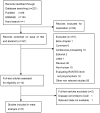RANTES gene G-403A polymorphism and coronary artery disease: a meta analysis of observational studies
- PMID: 23071760
- PMCID: PMC3468465
- DOI: 10.1371/journal.pone.0047211
RANTES gene G-403A polymorphism and coronary artery disease: a meta analysis of observational studies
Abstract
Objective: The G-403A polymorphism in RANTES gene may be involved in the development of coronary artery disease (CAD) through increasing RANTES-mediated leukocyte trafficking and activation. However, studies investigating the relationship between G-403A polymorphism and CAD yielded contradictory and inconclusive results. In order to shed some light on these inconsistent findings, a meta analysis was performed to clarify the role of G-403A polymorphism of RANTES gene in the susceptibility of CAD.
Methods: A systemic literature search of PubMed and EMBASE was conducted from their inception to March 23, 2012, to retrieve related studies. In addition, Conference Proceedings Citation Index-Science was searched, authors of relevant studies were contacted, and reference lists of the included studies and their related citations in PubMed were reviewed for additional pertinent studies.
Results: A total of 8 eligible studies were identified, with a total of 4252 CAD cases and 2150 controls. There was no evidence of significant association between G-403A polymorphism and CAD risk in any genetic model or pairwise comparisons (additive model: OR = 1.046, 95% CI = 0.883-1.239, I(2) = 65.9%; recessive model: OR = 1.140, 95% CI = 0.774-1.678, I(2) = 53.1%; dominant model: OR = 1.000, 95% CI = 0.820-1.21), I(2) = 62.6%; AA vs GG: OR = 1.141, 95% CI = 0.734-1.773, I(2) = 61.2%; GA vs GG: OR = 0.993, 95% CI = 0.800-1.232, I(2) = 64.6%). Subgroup analysis and meta regression indicated that ethnicity and genotyping method accounted for the significant heterogeneity among studies. In the stratified analysis by ethnic group, G-403A polymorphism was found to be associated with increased CAD risk in Caucasian population whereas its protective role was observed in Asian population in some but not all comparisons.
Conclusion: Data from the current meta-analysis do not support the existence of a relationship between G-403A polymorphism and the development of CAD, and large sample size study employing unified genotyping method is needed to further evaluate the influence of G-403A polymorphism on susceptibility of CAD.
Conflict of interest statement
Figures



References
-
- Li JJ (2011) Inflammation in coronary artery diseases. Chin Med J 124: 3568–3575. - PubMed
-
- Zernecke A, Weber C (2010) Chemokines in the vascular inflammatory response of atherosclerosis. Cardiovasc Res 86: 192–201. - PubMed
-
- Pattison JM, Nelson PJ, Huie P, Sibley RK, Krensky AM (1996) RANTES chemokine expression in transplant-associated accelerated atherosclerosis. J Heart Lung Transplant 15: 1194–1199. - PubMed
-
- Schober A, Manka D, von Hundelshausen P, Huo Y, Hanrath P, et al. (2002) Deposition of Platelet RANTES Triggering Monocyte Recruitment Requires P-Selectin and Is Involved in Neointima Formation After Arterial Injury. Circulation 106: 1523–1529. - PubMed
Publication types
MeSH terms
Substances
LinkOut - more resources
Full Text Sources
Medical
Miscellaneous

